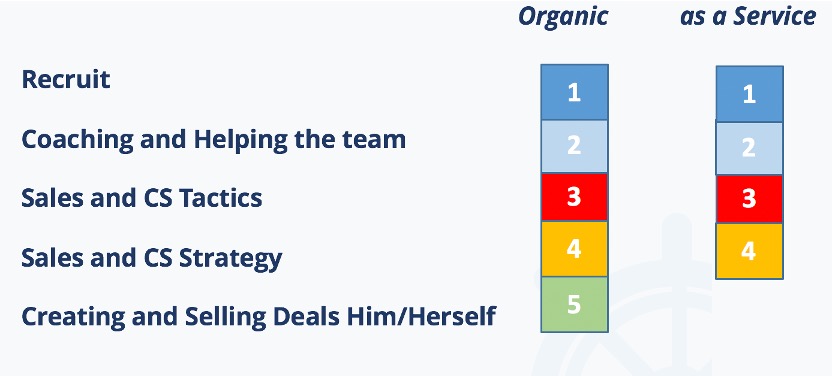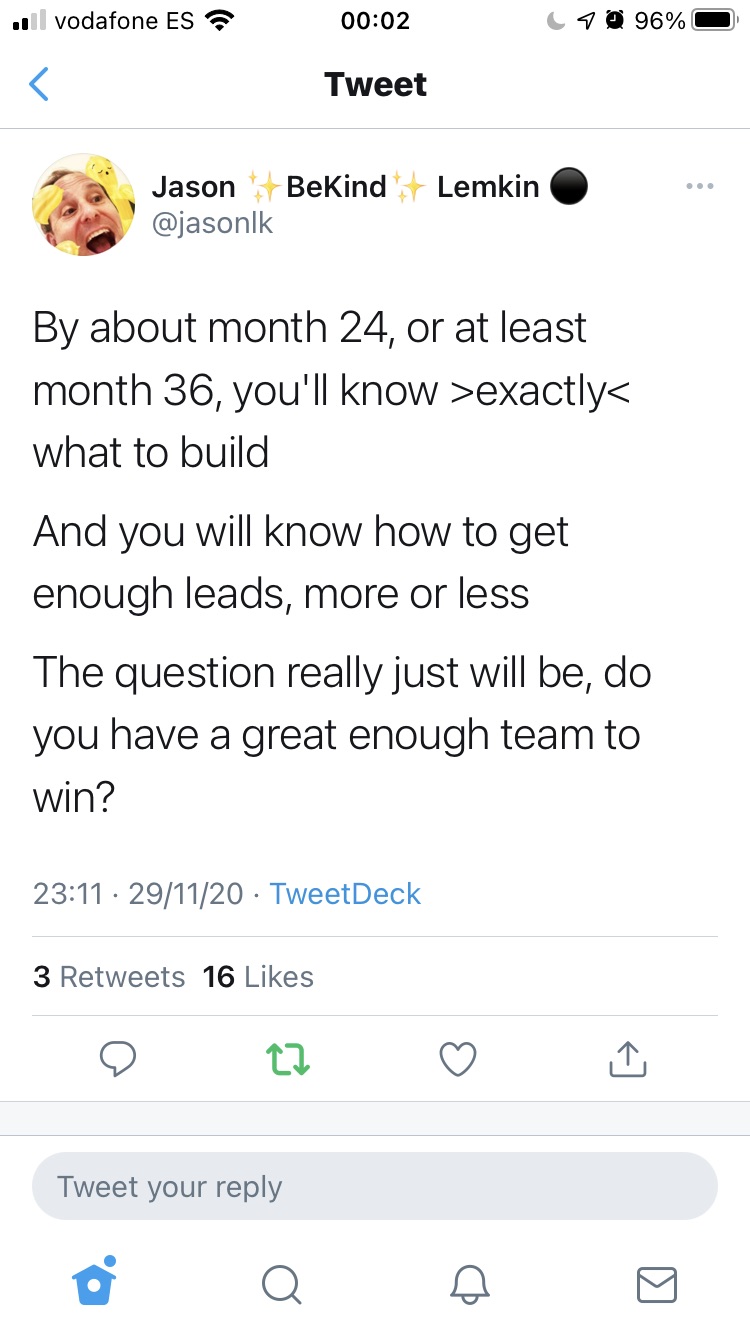SaaS Revenue Leaders are expensive:
- Averages cash OTE (On Target Earnings which is the sum of basic/fixed salary + bonus/commissions)
- Equity grant or stock options per member
- Benefits (work from home, car allowance, health insurance, severance package, etc)
- Other elements of compensation (signing bonus, milestone cash payouts, severance, etc)
This is a big investment for a SaaS company. For a startup raising a series A or B in VC capital it means to budget at least 300K$ excluding equity grants and other benefits normally added to the cash package.
Table of Contents
Economic Risk
VC-backed early stage startups have a high economic risk hiring the “Maradona” VP Sales or Chief Revenue Officer when they are not ready.
Why is that (more to read here):
- Wrong timing. Founders hire a VP Sales and expect high-growth revenue from year 1 BUT fundamental “postures” of the go-to-market strategy haven’t been validated yet, for example positioning, ICP, strategic focus, price & packaging.
- Wrong expectation. If the startup hasn’t reached revenue predictability yet, the expectation towards the new Revenue Leader should be set in terms of building that predictability. Nine women cannot have a baby in one month.
- Wrong profile. Founders do not always have it clear What and Who they need. Typical mistakes: hiring profiles who are too junior to make the job, or too senior, or too “corporate”.
- Wrong onboarding. A VP Sales or Chief Revenue Officer is the most expensive hire in an early stage startup. You don’t win the league hiring “Michael Jordan” and leaving him to do all the job just because he’s so expensive. You need to know how to manage the onboarding of such a profile and create the conditions to make the person successful in your business.
As a result of the above issues, not necessarily because the person you hired was not the right fit:
- The average tenure of a revenue leader in VC-backed startups is less than 18 months (12 months if first time leader).
- Companies waste hundred of thousands € in hiring, headcount, operational and opportunity costs.
- Founders need additional funding and dilute their equity share (if existing VCs decide to support the follow on).
- VCs and the whole team become unhappy.
- The Boards tend to enter a “circle of hell” of Consultants, Advisors, hiring one VP after the other.
The harsh reality is that VCs always invest in what they believe to be future “Cinderellas” but often they realise in 12-36 months they may have invested in her “Stepsister” instead.
Read more on how VCs should deal with the fear of write-off in the “Stepsister” scenario. Link.
How to reduce the startup risk and prevent a “Cinderella” from becoming a “Stepsister”?
When sales do not happen as expected, Board and Founders tend to look at symptoms and not at causes.
The symptom is typically not reaching a revenue target that ultimately drives the Board to fire the VP Sales.
Replacing the VP with a new one does not lead to a better result most of the time, as far as the cause is not well understood.
It may be the ICP and customer segmentation that should be redefined.
It may be the positioning and the value proposition that needs to be looked at and transformed.
Frequently Founders miss the right focus. This means that often the issue is not a Sales problem at all. It’s a problem of Positioning, Strategic Focus, or Product/Price & Packaging.
The challenge in such a context is that Sales leaders in the SaaS space are typically great individual sales contributors that at some point in their career get promoted to a Director or VP Sales role.
At that point in time the truth is that their job is changed. The company does not need a great salesperson who is also good at managing people. It needs a strategic leader for the organization who is able to visualize the next 3 to 5 years, shape the go-to-market strategy of the business and translate it into an execution plan for the next 12-24 months, just to start with.
That’s a different job and not a job for everyone.
So, how do you get the CEOs to underline the right problems and make the right choices? What do they need to do more effectively?
The answer is picking the right person… Do you need a VP of Sales and do you understand what a VP of Sales is. Or do you need a Chief Revenue Officer and you understand what one of those is.
Having an experienced revenue leadership “in action” is the most important asset to build a successful revenue engine.
HIGH COST – HIGH FAILURE RATE – HIGH RISK
IS THERE A MORE EFFECTIVE, AGILE AND LESS RISKY APPROACH?
Seed-series A-series B are sensitive phases for VC-backed B2B SaaS startups. Experienced Revenue Leadership is probably the scarcest resource. There are no shortcuts and there is also quite a bit of VP “title inflation” primarily in Europe.
You don’t become “Michael Jordan” if you show up in a playground wearing his jersey.
Sometimes you may look like Michael Jordan in a playground but then when you go to play in a League, that’s a different story.
It’s also true that revenue leaders with a true track record aren’t much attracted anymore by very young VC-backed startups or by ex-“Cinderellas” in trouble because of the high personal risk.
Consultants and Strategic Advisors can be useful under certain circumstances but that’s not the solution.
Read the post about Consultants and Advisor.
What is missing in these circumstances is someone able to zoom-in & zoom-out in real time and help on execution.
So, why not thinking about a different framework to make things better and not waste value?
We are in the SaaSification era and today Everything is becoming as a Service.
Not only industries but also individual professions are SaaSing up.
Sales Development for example. Do you need to build a new SDR team? Instead of hiring new people with all the complexity linked to recruiting, contracting, headcounts, etc. , there are organizations that will make it easy for you. SDR as a Service.
C-level and executive jobs in scaleups can be SaaSed up. Think about CFO as a Service. I know people who built a business based on this concept. It makes 100% sense and it’s pretty scalable.
Revenue Leadership in Action and Growth Regeneration as a Service
In the last 3 years I validated a hands-on Revenue Leadership and Growth Regeneration as a Service framework that has allowed me to deliver high ROI and be instrumental in regenerating revenue strategies and engines (Sales, Customer Success, Product Marketing and Demand Generation) in 3-4 companies at the same time per year.
It’s not classic consultancy or strategic advisory. It’s work on the court like Phil Jackson or Tex Winter in case you have watched “The Last Dance” on Netflix. In that case the work was based on the “Triangle” game plan. In this case the game plan is SaaSup. Read more about it.
Through a systematic weekly routine of operational meetings condensed in a few-hour session plus quick catch-up calls and messages during the week plus (mandatory!) ongoing internal team execution we have built successfully from scratch or regenerated go-to-market strategies and engines in a number of startups and scaleups.
It’s not only about setting the right strategies, sales process and playbook. The key part of the work is the People and the hiring & coaching of more than 120 people to set them for success and help them execute, including juniors, managers and managers of managers (Directors and VPs).
What are the 3 key learnings?
1. Investors and Founders love it.
The ROI for the business is much higher than having to hire senior leadership organically.
The risk is lower.
Compared to an organic revenue leader, the “as a service” model can deliver pretty well the 4 most important things that you need from a leader. Only exception is selling herself which is the least important thing for a leader by the way.

2. It’s a win-win model if the cooperation vision is for the medium-long term, not transactional.
There is a cultural mindset in many CEOs and VCs that if you are not an organic VC Sales or Chief Revenue Officer, than you must be a Consultant, an Advisor or a part time VP. Well, it’s not necessarily like that.
As far as the business model is concerned, the focus is on outcomes linked to clear milestones like it would typically be for an organic VP or Chief Revenue Officer. You can build alignment with the medium/long term objectives of Founders and Investors with a much higher level of flexibility and agility.
3. Scalability of the model.
On an individual leader level, of course the scalability is limited. No more than 3-4 companies at the same time per year.
Nevertheless I strongly believe that a Revenue Engine as a Service operation can become scalable if internalized by “enlightened” Venture Capital firms. The size of the VCs should be in the range of a few billions at least.
Imagine in the same organization a few VPs and CROs as a Service, a few SDR Managers as a Service, CS as a Service and then allocating resources to portfolio companies in exchange of cash (or additional equity).
That would be so powerful, differentiating and effective.
Early stage startups do not need just money. They do not need advisors not involved in making things happen.
They need money & help on setting the right strategy & execution. In real time.
Will this be the future?
CONCLUSIONS
The model of Revenue Leadership in Action and Growth Regeneration as a Service can be highly effective in reducing the 3 key risks faced by early stage startups in the Seed-series A-series B phase in less mature ecosystem like Continental Europe and Latin America.
It reduces the economic risk.
Compared with an organic revenue leader not only the investment is lower and more agile/flexible, but also the ROI is higher in relative terms.
It reduces the startup risk.
It moves out from the “startup zone” to the “scaleup zone” through more professional approaches and processes.
It reduces the risk of making mistakes and then later regret.
It’s not a magician with a wand but an executor with a clear strategy and game plan to reduce the 3 key risks.
If you enjoyed this post, you will also like Game Plan for a Healthy Go-To-Market in B2B SaaS and How to Go Upmarket.

